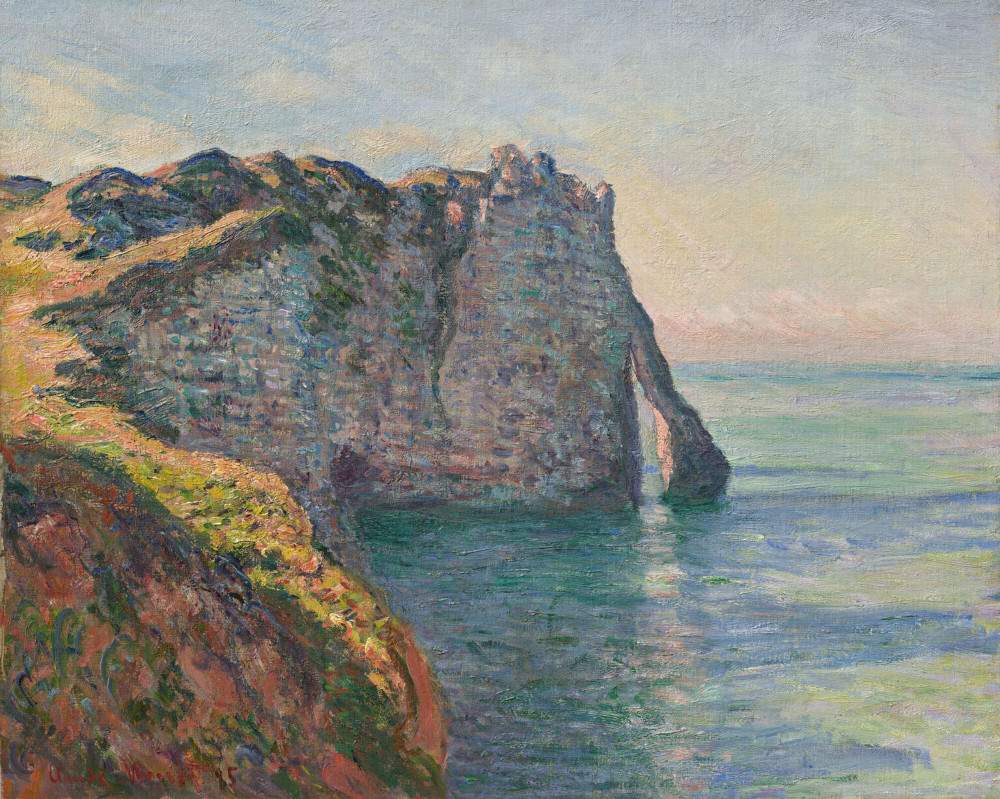Works on the road: a Monet painting from the Barberini Museum in Potsdam arrives in Rivoli
From Nov. 25, 2023 to Aug. 18, 2024, Claude Monet’s painting La Falaise et la Porte d’Aval, made in 1885 and coming from the Barberini Museum in Potsdam, will be housed at the Cerruti Collection, not far from Rivoli Castle. The exhibition of this painting inaugurates a new cultural exchange program that, in addition to enhancing the Collection’s works through their participation in national and international exhibitions of high scholarly value, also aims to promote the Rivoli house-museum as a place that offers the Turin public the opportunity to see great masterpieces from important public and private art collections live.
The first collaboration of the Opere in viaggio program, curated by Carolyn Christov-Bakargiev and Fabio Cafagna, involves the Barberini Museum in Potsdam, which, together with the Staatsgalerie Stuttgart, has requested the loan of Amedeo Modigliani’s 1918 painting Jeune femme à la robe jaune (Renée Modot) on the occasion of the exhibition Modigliani: Modern Gazes, curated by Ortrud Westheider and Christiane Lange with Nathalie Frensch, which will run from November 24, 2023 to March 17, 2024 at the Staatsgalerie Stuttgart and from April 26 to August 18, 2024 at the Barberini Museum in Potsdam.
The departure of Amedeo Modigliani’s work corresponds to the arrival in the halls of Villa Cerruti of Claude Monet’s painting from Museum Barberini. The presence at Villa Cerruti of an important work by Monet, an artist never acquired by Cerruti, is intended to complement the collector’s demonstrated interest inImpressionism, which over the years was manifested in the acquisition of works by Alfred Sisley, Pierre-Auguste Renoir, Paul Cézanne and the Italian Federico Zandomeneghi.
Monet’s painting La Falaise et la Porte d’Aval, chosen for the Rivoli house-museum, was made in the mid-1880s, a period when Monet traveled extensively, visiting several times the northern coasts of France and, in particular, the town of Étretat in Normandy, famous for its spectacular cliffs and the distinctive natural stone arch of the Porte d’Aval. Of all the regions visited during that period, the Normandy coast was the one that fascinated the artist the most. It was during an excursion to Étretat in early 1883 that, faced with the rock formations of the Porte d’Aval, Monet began to take an interest in the cliff motif, drawing inspiration, moreover, from Gustave Courbet’s earlier La Falaise d’Étretat après l’orage (1870), a work that was well received by critics at the 1870 Paris Salon and is now in the Musée d’Orsay in Paris.
In La Falaise et la Porte d’Aval at the Barberini Museum, the viewer’s gaze moves, along an arc-shaped trajectory, from the sunlit cliffs in the left foreground toward the center of the composition. A textural brushstroke of deep pink marks the break in the cliff and creates an evocative chromatic accent, echoed by the reflections that spread across the surface of the water. As in most canvases devoted to the Atlantic coast, the painter chose a deserted scene, devoid of humans, so as to evoke an absolute feeling of contemplative observation of nature. If in Courbet’s painting the elements were clearly traced and figuratively rendered in detail, Monet’s canvas is characterized by the loose brushwork and rendering of iridescent light effects typical of his Impressionist output in the 1880s.
The painting belonged to the Parisian opera singer Jean-Baptiste Faure, among the most important and early supporters of the Impressionists, who bought it in 1886 directly from the artist, then passed it on to the Durand-Ruel Gallery in Paris at the beginning of the new century. After passing through a number of Parisian collections, it was acquired by a private U.S. collection in the 1970s. Its entry into Hasso Plattner’s collection occurred in 2010.
Image: Claude Monet, La Falaise et la Porte d’Aval (1885; oil on canvas, 65 x 81 cm; Potsdam, Barberini Museum, Hasso Plattner Collection).
 |
| Works on the road: a Monet painting from the Barberini Museum in Potsdam arrives in Rivoli |
Warning: the translation into English of the original Italian article was created using automatic tools. We undertake to review all articles, but we do not guarantee the total absence of inaccuracies in the translation due to the program. You can find the original by clicking on the ITA button. If you find any mistake,please contact us.



























